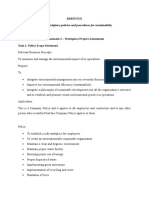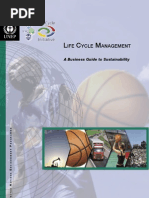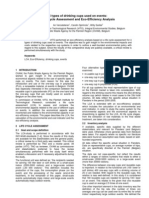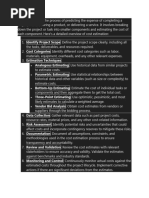0 ratings0% found this document useful (0 votes)
41 viewsA UNEP/SETAC Life Cycle Management Guide
A UNEP/SETAC Life Cycle Management Guide
Uploaded by
FJNovaes454This document summarizes a guide on Life Cycle Management (LCM) published by UNEP/SETAC. LCM is a systematic approach for businesses to apply life cycle thinking to reduce environmental impacts and improve socio-economic performance across a product's life cycle. The guide shows how LCM has been implemented successfully in companies worldwide. It describes LCM as a framework to incorporate sustainability into business strategy, product design, purchasing, and communications. While LCM uses tools like life cycle assessment, it is a flexible approach that can be gradually adopted by organizations. The document concludes that all organizations can benefit from LCM and provides recommendations for its implementation.
Copyright:
© All Rights Reserved
Available Formats
Download as PDF, TXT or read online from Scribd
A UNEP/SETAC Life Cycle Management Guide
A UNEP/SETAC Life Cycle Management Guide
Uploaded by
FJNovaes4540 ratings0% found this document useful (0 votes)
41 views2 pagesThis document summarizes a guide on Life Cycle Management (LCM) published by UNEP/SETAC. LCM is a systematic approach for businesses to apply life cycle thinking to reduce environmental impacts and improve socio-economic performance across a product's life cycle. The guide shows how LCM has been implemented successfully in companies worldwide. It describes LCM as a framework to incorporate sustainability into business strategy, product design, purchasing, and communications. While LCM uses tools like life cycle assessment, it is a flexible approach that can be gradually adopted by organizations. The document concludes that all organizations can benefit from LCM and provides recommendations for its implementation.
Original Title
8
Copyright
© © All Rights Reserved
Available Formats
PDF, TXT or read online from Scribd
Share this document
Did you find this document useful?
Is this content inappropriate?
This document summarizes a guide on Life Cycle Management (LCM) published by UNEP/SETAC. LCM is a systematic approach for businesses to apply life cycle thinking to reduce environmental impacts and improve socio-economic performance across a product's life cycle. The guide shows how LCM has been implemented successfully in companies worldwide. It describes LCM as a framework to incorporate sustainability into business strategy, product design, purchasing, and communications. While LCM uses tools like life cycle assessment, it is a flexible approach that can be gradually adopted by organizations. The document concludes that all organizations can benefit from LCM and provides recommendations for its implementation.
Copyright:
© All Rights Reserved
Available Formats
Download as PDF, TXT or read online from Scribd
Download as pdf or txt
0 ratings0% found this document useful (0 votes)
41 views2 pagesA UNEP/SETAC Life Cycle Management Guide
A UNEP/SETAC Life Cycle Management Guide
Uploaded by
FJNovaes454This document summarizes a guide on Life Cycle Management (LCM) published by UNEP/SETAC. LCM is a systematic approach for businesses to apply life cycle thinking to reduce environmental impacts and improve socio-economic performance across a product's life cycle. The guide shows how LCM has been implemented successfully in companies worldwide. It describes LCM as a framework to incorporate sustainability into business strategy, product design, purchasing, and communications. While LCM uses tools like life cycle assessment, it is a flexible approach that can be gradually adopted by organizations. The document concludes that all organizations can benefit from LCM and provides recommendations for its implementation.
Copyright:
© All Rights Reserved
Available Formats
Download as PDF, TXT or read online from Scribd
Download as pdf or txt
You are on page 1of 2
A UNEP/SETAC Life Cycle Management Guide
Allan Astrup Jensen*,
1
Arne Remmen,
2
Jeppe Frydendal,
3
Sonia Valdiva,
4
and Guido Sonnemann
4
1
FORCE Technology, Park Alle 345, DK-2605 Broendby, Denmark, aaj@force.dk
2
Aalborg University, ar@plan.aau.dk
3
Danish Standards, jf@ecolabel.dk
4
UNEP DTIE Paris, Sonia.Valdivia@unep.fr; Guido.Sonnemann@unep.fr
In connection with the UNEP/SETAC Life Cycle Initiative the publication: Life Cycle Management - a Business
Guide to Sustainability has been produced. The publication shows how application of life cycle thinking can be and
have been implemented in companies and other organizations around the World in order to reduce resource
consumption and emissions to the environment, as well as improve the socio-economic performance, in all stages of a
products life in the value chain.
Introduction
The journey towards sustainability requires that
businesses, governments and individuals take action,
i.e., changing consumption and production behaviours,
setting policies and changing practices, improving the
quality of life. Businesses have to find innovative ways
to be profitable and at the same time expand the
traditional business to include the environmental and
social dimensions coined the Triple Bottom Line,
and to introduce Product Life Cycle Thinking.
The main aim of Life Cycle Thinking is to reduce
resource consumptions and emissions to the
environment, as well as improve the socio-economic
performance, in all stages of a products life.
Results
In connection with the UNEP/SETAC Life Cycle
Initiative the publication: Life Cycle Management - a
Business Guide to Sustainability has been produced.
1
Earlier, in 2005 a more detailed Background Document
for Life Cycle Management was published based on
input from three UNEP/SETAC LCM Task Forces.
2
Life Cycle Management (LCM) is a systematic
application of life cycle thinking in modern business
practice with the aim to provide the societies with more
sustainable goods and services and to manage the total
life cycle of an organizations product portfolio
towards more sustainable production and consumption.
Discussion
LCM can facilitate the link between the economic,
social and environmental dimensions within a
company.
LCM is explicitly aimed to modify and improve the
performance of product systems and supports the
business assimilation of, for example, environment-
oriented product policies.
Life Cycle Management (LCM) is for organizations,
which have adopted a strategy expressing a wish to
produce or trade products, which should be as
sustainable as feasible, to improve their public image,
visibility and general relations to stakeholders, increase
their shareholder value and keep it persistent, work
towards being a sustainable business and be in the
forefront of competitors, be at the edge of and prepared
for future legislative developments.
LCM is systematic integration of sustainability in
company strategy and planning, in product design and
development, in purchasing decisions and in
communication programs in order to minimize
environmental and socioeconomic burdens associated
with a product or product portfolio during its entire life
cycle and value chain.
LCM is voluntary and can be gradually adapted to the
specific needs and characteristics of individual
organizations. LCM is not a single tool or methodology
but a flexible management framework of programs,
concepts, techniques and procedures incorporating
environmental, economic, and social aspects of
products, processes and organizations.
LCM is not an application of Life Cycle Assessment
(LCA) but LCA is one of many tools, techniques,
concepts and programmes which may be a part of a
Life Cycle Management System. Other tools etc. could
be Life Cycle Costing, Cost Benefit Analysis, Material
Flow Cost Accounting, Eco-design, Eco-labelling,
Green Procurement, Suppliers Code of Conduct, and
Corporate Social Responsibility.
LCM is a new concept, and the definitions of terms are
not yet standardized, and procedures and
methodologies are still open for discussion.
Conclusion
All organizations can implement a LCM program, and
in this Guide there are many examples of ongoing
programmes with successful results.
Continued high priority by top management and active
participation of all departments, functions and
employees in a company are essential.
Every department have a role to play and have different
interests and stakeholders. An environmental or
sustainability department will often co-ordinate the
Proceedings of the CILCA2007 International Conference of Life Cicle Assessment
implementation of LCM and the training of employees
in the company and in suppliers.
The organization must go beyond its facility
boundaries and be willing to expand its collaboration
and communication to all stakeholders in the value
chain.
Implementation of LCM is a dynamic process;
organizations may begin with small goals and
objectives with the resources they have and get more
ambitious over time.
For the implementation a step by step approach is
useful. Special attention should be given to activities
that can secure continuous improvement.
The Plan-Do-Check-Act cycle is recommended to be
applied as in several other management systems.
References
1. A. Remmen, A.A. Jensen, J. Frydendal. Life Cycle
Management A Business Guide to Sustainability,
UNEP DTIE, Paris, 2006 (in press).
2. A. A. Jensen, A. Remmen (eds). Background
Report for a UNEP Guide to Life Cycle
Management A Bridge to Sustainable Products,
UNEP DTIE, Paris, 2005. (to be downloaded from
http://lcinitiative.unep.fr)
Proceedings of the CILCA2007 International Conference of Life Cicle Assessment
You might also like
- Sustainability Management Question BankDocument16 pagesSustainability Management Question Bankdeeksha6548gkNo ratings yet
- ISO 14001 Step by Step - A practical guide: Second editionFrom EverandISO 14001 Step by Step - A practical guide: Second editionRating: 5 out of 5 stars5/5 (1)
- Pas 2050-1 - 2012Document46 pagesPas 2050-1 - 2012milovanmNo ratings yet
- BSBSUS511 - T2 - Develop Workplace PoliciesDocument13 pagesBSBSUS511 - T2 - Develop Workplace PoliciesJochieng100% (1)
- Task 2 501Document3 pagesTask 2 501Betty Betty20% (5)
- Module-2 Topic-UnileverDocument11 pagesModule-2 Topic-UnileverYogesh Kumar0% (1)
- 9_Life Cycle Management 2023_2024Document35 pages9_Life Cycle Management 2023_2024Oussama FathallahNo ratings yet
- TCC Camila Final PDFDocument53 pagesTCC Camila Final PDFCamila MarçalNo ratings yet
- Life Cycle Management - A Business Guide To SustainabilityDocument52 pagesLife Cycle Management - A Business Guide To Sustainabilitykayyappan1957100% (2)
- Unit 6Document11 pagesUnit 6agrawaltejas947No ratings yet
- SE M3Document16 pagesSE M3digitalorbis2003No ratings yet
- Life Cycle ManagementDocument2 pagesLife Cycle ManagementbongricoNo ratings yet
- Life Cycle ThinkingDocument3 pagesLife Cycle ThinkingSteven ChoiNo ratings yet
- GSP BrochureDocument32 pagesGSP BrochureAlvan ZaputraNo ratings yet
- Guideiso 14001 Cyclevieenec 2017 OnlineDocument56 pagesGuideiso 14001 Cyclevieenec 2017 Onlinerajivfr144No ratings yet
- Businee & Sustainability m3-1Document9 pagesBusinee & Sustainability m3-1SOMNATH KHANNo ratings yet
- Unit 6Document22 pagesUnit 6Arsh KaitNo ratings yet
- BSBSUS511 LessonDocument65 pagesBSBSUS511 LessondarwinnftsNo ratings yet
- Life Cycle Assessment_ A Systems Approach to Environmental Management and Sustainability _ AIChEDocument10 pagesLife Cycle Assessment_ A Systems Approach to Environmental Management and Sustainability _ AIChEVVG LabNo ratings yet
- Eco Efficiency Explain at IonDocument13 pagesEco Efficiency Explain at IonAnh Bui TuanNo ratings yet
- Life Cycle Assessment 14.06.2016Document32 pagesLife Cycle Assessment 14.06.2016haider.sahil180No ratings yet
- Module 1ADocument49 pagesModule 1Aprajwalp4124No ratings yet
- LECTURE 2 Corporate Social ResponsibilityDocument25 pagesLECTURE 2 Corporate Social Responsibilityn0195520kNo ratings yet
- EvsDocument78 pagesEvsRashmi BendreNo ratings yet
- An Introduction To Responsible CareDocument50 pagesAn Introduction To Responsible CareGarima KaliaNo ratings yet
- Corporate Sustainability PracticesDocument45 pagesCorporate Sustainability PracticesM ManjunathNo ratings yet
- Life CycleDocument352 pagesLife CycleWalter Salas100% (3)
- Briefing Report TemplateDocument7 pagesBriefing Report TemplateBirendra Parajuli100% (1)
- Environmental Protection SUPER IMPDocument61 pagesEnvironmental Protection SUPER IMPsharan rajNo ratings yet
- Implementing Corporate Environmental StrategiesDocument37 pagesImplementing Corporate Environmental StrategiesDavid BoyerNo ratings yet
- Module 3 NotesDocument17 pagesModule 3 Notesajeesh.sNo ratings yet
- Tool To Incorporate Environmental Costs Into Life Cycle AssessmentDocument11 pagesTool To Incorporate Environmental Costs Into Life Cycle AssessmentRonoNo ratings yet
- Chap 3 Sustainable Assessment ToolsDocument66 pagesChap 3 Sustainable Assessment ToolsNaufal Syafiq Mohd IsaNo ratings yet
- Week 4-5-Creating Futures Sustainable Enterprise and Innovation - Promoting SustainabilityDocument36 pagesWeek 4-5-Creating Futures Sustainable Enterprise and Innovation - Promoting SustainabilityAfaf AnwarNo ratings yet
- MBA Indroduction of Sustainable Development Topics Friday June14 2024Document6 pagesMBA Indroduction of Sustainable Development Topics Friday June14 2024kebejik384No ratings yet
- Lecture 7 NewDocument6 pagesLecture 7 NewDany JosephNo ratings yet
- Eco Design ManualDocument4 pagesEco Design Manualacampos2012No ratings yet
- Sustainable Manufacturing DavimDocument20 pagesSustainable Manufacturing DavimtalhawasimNo ratings yet
- Environmental Management Systems History and New TendenciesDocument17 pagesEnvironmental Management Systems History and New TendenciesAderlanio Cardoso100% (1)
- Sustainability 06 09179Document26 pagesSustainability 06 09179johnSianturiNo ratings yet
- Improving Environmental Awareness Training in BusinessDocument12 pagesImproving Environmental Awareness Training in Businesshsc0728No ratings yet
- 2Document1 page2Zyra YumulNo ratings yet
- Manual On Material Flow Cost Accounting ISO14051-2014Document37 pagesManual On Material Flow Cost Accounting ISO14051-2014Varun IngleNo ratings yet
- Literature Review On Iso 14001Document8 pagesLiterature Review On Iso 14001afmzrxbdfadmdq100% (1)
- Manual On Material Flow Cost Accounting ISO14051-2014 PDFDocument37 pagesManual On Material Flow Cost Accounting ISO14051-2014 PDFSyarief HuseinNo ratings yet
- What Is A Life Cycle Assessment (LCA) ?Document6 pagesWhat Is A Life Cycle Assessment (LCA) ?Pradeep AnuradhaNo ratings yet
- EM Module VDocument15 pagesEM Module VAndrea FernandesNo ratings yet
- Implementation of ISO 14000 in Luggage Manufacturing Industry: A Case StudyDocument14 pagesImplementation of ISO 14000 in Luggage Manufacturing Industry: A Case StudyDevspringNo ratings yet
- Workshop - Environmental Management Accounting: Towards An Internationally Validated ProcedureDocument27 pagesWorkshop - Environmental Management Accounting: Towards An Internationally Validated ProcedureDewa KematianNo ratings yet
- Case Study - External Environment - NestleDocument2 pagesCase Study - External Environment - NestlebgbhattacharyaNo ratings yet
- Environment Management MODULE-5Document16 pagesEnvironment Management MODULE-5AlthafNo ratings yet
- HAT301 - T2 - 2019 - Workshop - 05 - v1 - Attraction - and - Event - ManageentDocument33 pagesHAT301 - T2 - 2019 - Workshop - 05 - v1 - Attraction - and - Event - ManageentPhuong NhungNo ratings yet
- Cleaner Production CompleteDocument39 pagesCleaner Production CompleteAlyssa AdamsNo ratings yet
- Brochure Cambridge SUST 20-07-2022 V20 PDFDocument15 pagesBrochure Cambridge SUST 20-07-2022 V20 PDFRita SerpaPintoNo ratings yet
- Laundry Shop EMS PlanDocument21 pagesLaundry Shop EMS PlanDaisy ResosNo ratings yet
- Development of CP Policies: Approaches and Instruments: Guidelines For The CP CentresDocument97 pagesDevelopment of CP Policies: Approaches and Instruments: Guidelines For The CP CentresGurvinder AroraNo ratings yet
- Life Cycle Approaches To Sustainable Consumption A Critical ReviewDocument12 pagesLife Cycle Approaches To Sustainable Consumption A Critical ReviewAmir JoonNo ratings yet
- Environment Protection ManagementDocument14 pagesEnvironment Protection ManagementmanikantbiserottiNo ratings yet
- A Lean Approach To Developing Sustainable Supply ChainsDocument33 pagesA Lean Approach To Developing Sustainable Supply Chainsdoddy ChannelNo ratings yet
- Sustainable Design - SolidWorks PDFDocument44 pagesSustainable Design - SolidWorks PDFYash NagarNo ratings yet
- Sustainability Business Strategy Nestle.Document12 pagesSustainability Business Strategy Nestle.gurpreetNo ratings yet
- Types of PolymerizationDocument98 pagesTypes of PolymerizationFJNovaes454No ratings yet
- PolymerDocument33 pagesPolymerFJNovaes454100% (1)
- Lactate Doesn T Necessarily Cause Fatigue Why Are We SurprisedDocument1 pageLactate Doesn T Necessarily Cause Fatigue Why Are We SurprisedFJNovaes454No ratings yet
- Polymer ChemistryDocument114 pagesPolymer ChemistryFJNovaes454100% (1)
- Barrier PolymersDocument66 pagesBarrier PolymersFJNovaes454100% (1)
- 105 0002E CapabilityDocument34 pages105 0002E CapabilityFJNovaes454No ratings yet
- Polymer Modifier Solutions GuideDocument12 pagesPolymer Modifier Solutions GuideFJNovaes45450% (2)
- Americhem Weathering TestsDocument26 pagesAmerichem Weathering TestsFJNovaes454No ratings yet
- 4 Types of Drinking Cups Used On Events LCADocument6 pages4 Types of Drinking Cups Used On Events LCAFJNovaes454No ratings yet
- Brochura PCP TiconaDocument84 pagesBrochura PCP TiconaFJNovaes454No ratings yet
- The Handbook of Managing and Marketing Tourism Experiences: Article InformationDocument21 pagesThe Handbook of Managing and Marketing Tourism Experiences: Article InformationAmazon AssociatesNo ratings yet
- Comprehensive Study Guide For Fundamentals of Building Construction, 7th Edition by Edward Allen and Joseph IanoDocument22 pagesComprehensive Study Guide For Fundamentals of Building Construction, 7th Edition by Edward Allen and Joseph Ianomaryarchitect25No ratings yet
- Project Risk Management and Procurement Management: OutcomesDocument29 pagesProject Risk Management and Procurement Management: OutcomesKhalil RushdiNo ratings yet
- Bamboo Use in Construction Industry: How Sustainable Is It?: September 2015Document14 pagesBamboo Use in Construction Industry: How Sustainable Is It?: September 2015Sakshi AgrawalNo ratings yet
- Opm530 Group AssignmentDocument10 pagesOpm530 Group AssignmentyuhanaNo ratings yet
- RRL 3Document15 pagesRRL 3omaxebryanNo ratings yet
- Records Management Practices To Improve EfficiencyDocument22 pagesRecords Management Practices To Improve EfficiencyManal JlilNo ratings yet
- Cost EstimationDocument2 pagesCost Estimationshlokkharat09No ratings yet
- Chap013 Target Costing Cost MNGTDocument49 pagesChap013 Target Costing Cost MNGTramaNo ratings yet
- Life Cycle Sustainability Assessment of Fly Ash Concrete StructuresDocument13 pagesLife Cycle Sustainability Assessment of Fly Ash Concrete StructuresAnatta OngNo ratings yet
- Life Cycle Analysis (LCA) For The Incorporation of Rice Husk Ash in Mortar Coating PDFDocument7 pagesLife Cycle Analysis (LCA) For The Incorporation of Rice Husk Ash in Mortar Coating PDFJosé Antonio Cruz DíazNo ratings yet
- 22p3915 Sampling Design Guidelines Part1Document104 pages22p3915 Sampling Design Guidelines Part1Oscar GomezNo ratings yet
- Green Highway For Malaysia: A Literature ReviewDocument8 pagesGreen Highway For Malaysia: A Literature ReviewDevaki sitoulaNo ratings yet
- Sartal Et Al 2014 The Sustainable Manufacturing Concept Evolution and Opportunities Within Industry 4Document17 pagesSartal Et Al 2014 The Sustainable Manufacturing Concept Evolution and Opportunities Within Industry 4Luca Vaccari AlmeidaNo ratings yet
- Plant Factory in Japan Current SituationDocument4 pagesPlant Factory in Japan Current Situationgisel366No ratings yet
- AMMP: A New Maintenance Management Model Based On ISO 55000: Infrastructure Asset Management January 2016Document11 pagesAMMP: A New Maintenance Management Model Based On ISO 55000: Infrastructure Asset Management January 2016Repositorio MantenimientoNo ratings yet
- Practice 13-53 Clevenger PDFDocument46 pagesPractice 13-53 Clevenger PDFBilalNo ratings yet
- Environmental Product Declaration: Interpon D2000 Powder CoatingsDocument22 pagesEnvironmental Product Declaration: Interpon D2000 Powder CoatingsmaNo ratings yet
- SpecificationDocument34 pagesSpecificationNaim ShakilNo ratings yet
- 3300 Life Cycle UpdateDocument4 pages3300 Life Cycle Updatepitipat nimnomNo ratings yet
- Facility Design GuidelinesDocument418 pagesFacility Design GuidelinestamailhamNo ratings yet
- Logistics Research Papers PDFDocument7 pagesLogistics Research Papers PDFh02qbcz8100% (1)
- Aligning Profit and Environmental Sustainability Stories From IndustryDocument20 pagesAligning Profit and Environmental Sustainability Stories From IndustryuttuttimailNo ratings yet
- Preview of The Comprehensive Guide For Selecting Interior FinishesDocument18 pagesPreview of The Comprehensive Guide For Selecting Interior Finishesgaurav20jainNo ratings yet
- Green Building PresentationDocument12 pagesGreen Building PresentationFavian JonathanNo ratings yet
- ProjectManager Project Plan Template ND23Document11 pagesProjectManager Project Plan Template ND23bgpexpertNo ratings yet
- Influence of Supplementary Cementitious Materials On The Sustainability Parameters of Cements and Concretes in The Indian ContextDocument11 pagesInfluence of Supplementary Cementitious Materials On The Sustainability Parameters of Cements and Concretes in The Indian ContextVikas SharmaNo ratings yet
- Hiab Method 1 2012 Customer Magazine Original 46182Document36 pagesHiab Method 1 2012 Customer Magazine Original 46182smilewithbalajithNo ratings yet
- Exploring Variation in Econ, Environm, Soc Performance Among Dutch Fattening Pig Farms 12p SKDocument12 pagesExploring Variation in Econ, Environm, Soc Performance Among Dutch Fattening Pig Farms 12p SKdainesecowboyNo ratings yet



































































































